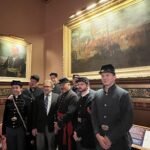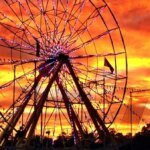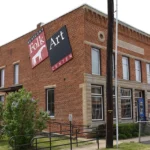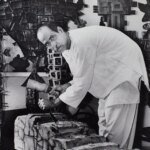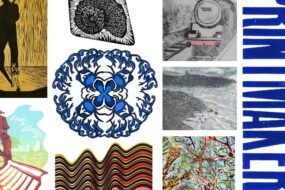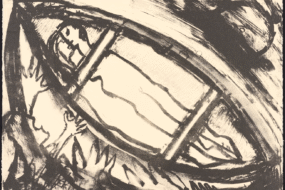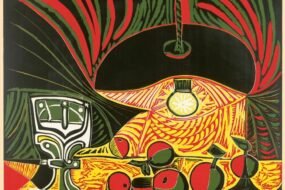
You know that moment when a lesser-known actor steals the show from the leading star? It has now happened to Hamlet, Apollo, Mercury,
and Jesus. A cavalry of heroines has seized the spotlight from them in the ultimate twist of the cultural season.
Whether navigating the carnage on the battlefield or at home, from a buzzing kitchen or a galloping horse, the fierce female spirit invigorates the 75 lithographs, woodcuts, and engravings on view at Norton Museum of Art through August 11.
An exhibition spanning nearly five centuries of European and American printmaking and hosting Old Masters such as Rembrandt Van Rijn and Albrecht Dürer does not exactly spell out female power. And yet, it is precisely in “The Paper Trail: 500 Years of Prints from the Jonathan ‘Jack’ Frost Collection” that women appear as something other than nudes and bathers. Enter an armor-clad girl, sword in hand and hair lost to the wind, leading men into battle. That’s what we call refreshing.
Our Joan of Arc-like warrior was conceived by Italian illustrator Bartolomeo Pinelli, who places the ardent cavalrywoman at the center of an intense encounter. Dark lines bring her into focus while reserve troops rendered in feeble marks, like a ghost army, await orders in the background. The highly descriptive title of this engraving from 1826 holds back details about the enigmatic knight: “And the golden hair scattered in the wind, a young woman appeared in the middle of the field.” Another thing the action-packed frame doesn’t offer is hope for her fate. Every second brings new losses, and the fallen are already piling up on the ground. She might join them at any moment. She might have a death wish. Good soldiers despise dying in bed, and our heroine is no different.


LEFT: Apollo Flaying Marsyas, undated etching and engraving by Jan Van Orley. Photo by Gretel Sarmiento. Running through August 11, “The Paper Trail traces the history and evolution of printmaking.
The female protagonist in “Judith Holding Severed Head of Holofernes” already claimed a victory of sorts, which portrays the legendary Jewish widow holding her flesh trophy. It’s not as graphic as it sounds. Dutch artist Crispijn De Passe, I didn’t traffic in gore. We scan for drops of blood and stains, but none are to be found. Seemingly unaware of its decapitated state, the head of the deceased Assyrian general appears to sleep soundly instead of suspended in a state of agony. The composed state of the young woman masks the true horror told by this print from the Baroque period.


Detail of Juno (1596), engraving by Hendrick Goltzius is among 75 prints highlighting old and modern masters of printmaking. GRETEL SARMIENTO / FLORIDA WEEKLY
She has just saved her city from a brutal attack by beheading the leader of enemy forces camping in nearby tents –shown here in the background. Having carried out the premeditated act, she is as cool as a cucumber. Even the ribbon holding her hair remains in place. A calm demeanor following such a violent act is indicative of underlying trauma. Before growing numb, this woman felt trapped and optionless. Having taken matters into her own hands, she is now executioner and victim. Guilty and innocent.
Arranged chronologically, the code-cracking exhibition maps the evolution of one of the greatest inventions of all time by highlighting various styles and techniques. Its documentary-like feel is further pronounced by grouping the works into five sections: Renaissance, Baroque, Rococo and Neoclassicism, Realism and Impressionism, and Modernism and Beyond. Among the artists represented are Anthony Van Dyck, François Boucher, Edgar Degas, Edouard Manet, Henry Moore, Thomas Moran, Marc Chagall, Paul Gauguin, and lesser known artists.


LEFT TO RIGHT: The Bear Pit in the Zoological Garden (1851), lithograph by Adolf Friedrich Menzel. Reclining Woman (1913), woodcut by German artist Erich Heckel. Frogs by painter and anatomist Jacques Fabien Gautier d’Agoty. Photos by Gretel Sarmiento.
Those looking for evidence of mastery will have plenty of opportunities to appreciate exquisite lines and dramatic use of lights and shadows courtesy of mythological scenes, Shakespearean tragedies, and idyllic landscapes. The closer to modern times, the more colorful the selection gets. (Let “Frogs,” an eye-catching scientific illustration by French anatomist and painter Jacques Fabien Gautier d’Agoty, be your compass.)
Another stunning print that benefited from progress and experimentation is “La Promenade (Landscape with Cypresses)” which features three ethereal young women dancing in a circle. Dressed in long pale tunics and framed by a line of handsome, tall trees, they might as well be Greek goddesses. Quick, delicate dashes contribute to the pointillist quality of this romantic lithograph by French artist Henri-Edmond Cross from 1897. The blue coloration washing over the boats, foliage, and mountains adds a dreamy, harmonious quality. We are not surprised to learn that the Mediterranean coast of France inspired this poetic work.
Balancing the softness of this landscape is a 1913 woodcut by German artist Erich Heckel, which showcases the power of radical simplicity. “Liegende Frau (Reclining Woman)” pairs sharp corners and bold edges. The hardened figure of a dark-haired woman comes into view out of an assortment of impulsive black lines. The flat composition makes us wonder whether the protagonist is standing, sleeping, or this is an aerial view of a dramatic fall. The suspicious bubble around her, painted a bright red, ignites the picture and enhances the contrast. For a moment, it seems she abandons her stiff pose to pierce it. Is it growing around her or squeezing her?
Even when ruling from a modest post, such as the rudimentary peasant setting depicted in “Interior of a Kitchen,” the female figure manages to command attention. She is fully immersed in her domestic routine in this etching from 1650 by Flemish painter David Teniers the Younger. A bountiful array of essential goods –including pots and turnips– piles up in the shaded foreground, signaling a break from austerity. They make for an improvised still life that can stand on its own. A slaughtered ox –the most precious possession of the bunch– hangs under the sun in the background, near the busy woman and a male companion. The man does right by not interrupting her. She has no patience for distractions.
Drawn from a Florida-based collection carefully cultivated over decades and now making its public debut, the works on view represent a droplet of an epic promised gift of about 700 prints the museum announced earlier this year. Once “The Paper Trail” closes on August 11, about 60 prints will enter the museum’s collection immediately. When the entire gift is handed over, the holdings of the works on paper will see a considerable boost in size and range.






